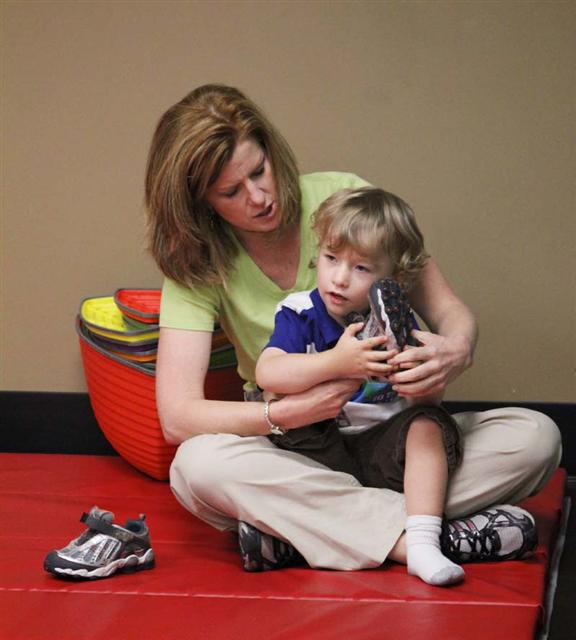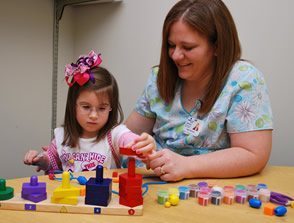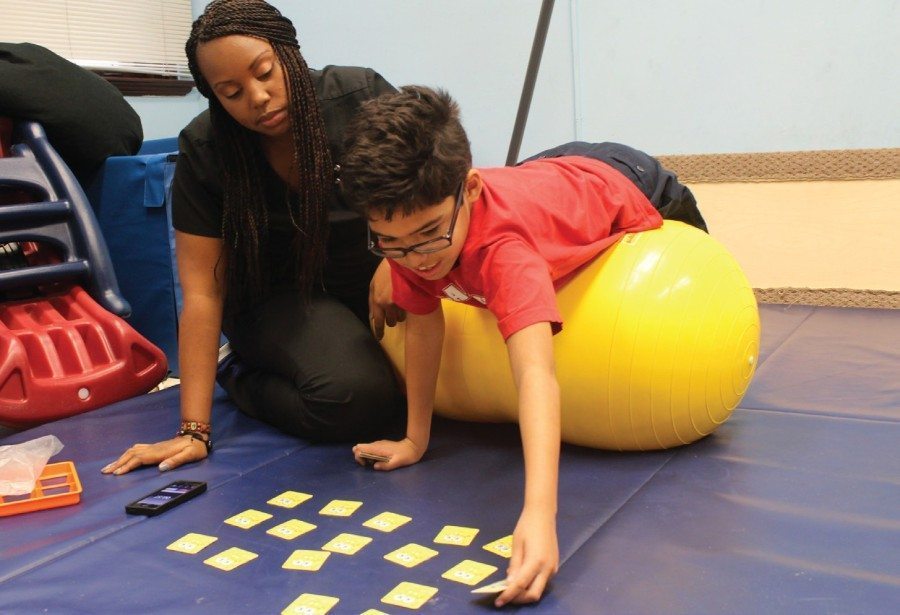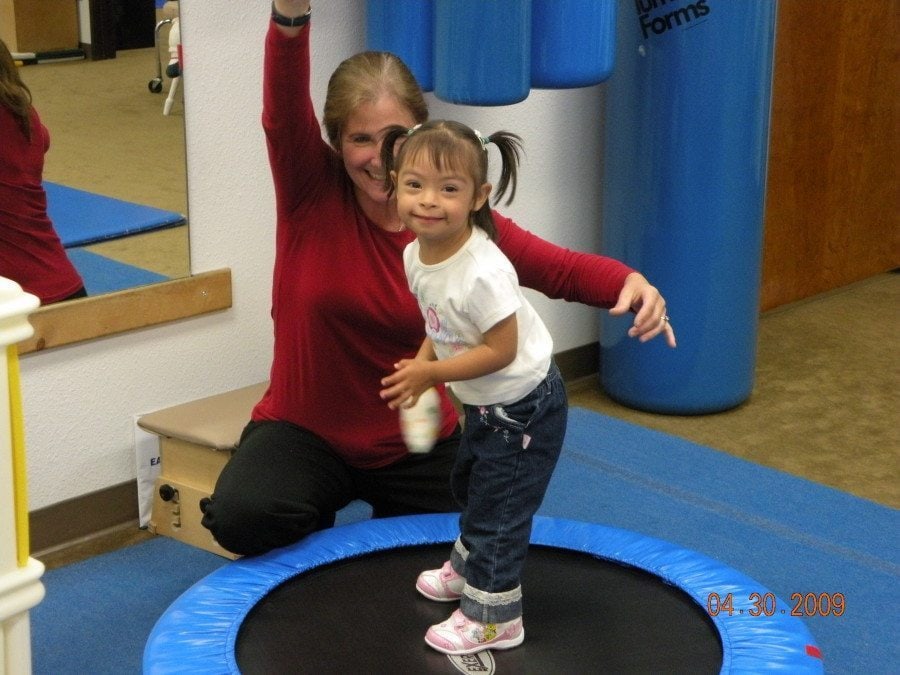Last updated on February 5th, 2024 at 10:59 am
An occupational therapist explains the basics of occupational therapy, sensory integration and processing, and what is seen in early intervention services.
As an occupational therapist, I frequently find myself answering two important questions: 1. what is occupational therapy? And 2. What is sensory integration? I could talk for days answering either question and the passion I have for what I do.
In this article, I will try to discuss the basics of occupational therapy, sensory integration and processing, and what may be commonly seen in early intervention services.
What Is Occupational Therapy (OT)?
And before anyone can answer – no, I do not help people find jobs, or at least not in the way you might think.
Occupational therapy is a therapy provided to any person of any age to help him or her achieve the highest level of independence with everyday tasks. Therapy typically takes the form of teaching individuals new skills or re-teaching skills that may have been lost or hindered due to injury, illness, or disability. OTs often employ adapted methods and adaptive equipment in treatment to achieve independence.

Some Areas of Treatment Include:
- activities of daily living (ADLs), such as dressing, feeding, toileting;
- instrumental activities of daily living (IADLs), such as home management, shopping, and cooking;
- leisure activities;
- school-based and educational activities;
- community re-integration;
- work tasks, such as interviewing to finding appropriate jobs for individuals with special needs and social skills;
- as well as sensory integration just to name a few.
You will find occupational therapists in schools, homes, hospitals, nursing homes, and community facilities — just about anywhere, really.
What Is Sensory Integration?
Our bodies are made up of many systems, like the cardiovascular or neurological systems, that help us function properly, and the sensory system is just as important.
Our sensory system is made to receive, filter, interpret and organize various sensory input throughout our lives. We receive information through different sensory experiences and stimuli including touch, whether light or deep (also known as proprioception), smell, sight, hearing, tasting, and movement, also known as vestibular input.
Vestibular input has to do with how we perceive our bodies in space and gives us a sense of feeling grounded or not. The information is then processed/interpreted and organized in our brain, and we are able to react to the stimulus.
When our sensory system is not functioning properly, we have difficulty doing any or all of those functions when we encounter sensory input, and this may cause an individual to act differently in response to a specific stimulus. We can be receiving too much or too little sensory input, which can make individuals seek out, avoid, or react to certain sensations in ways that may look odd or disconcerting.

Imagine sitting in a crowded auditorium for a presentation on an interesting topic. You experience all kinds of sensory input such as loud noises from other people, the sound system, or the large fluorescent lights. You may smell new and different smells such as other people or wax from the floors. Your eyes may need time to adjust to the bright lighting in the room, and it might make you squint or need to cover your eyes a bit to see the presenter well. You may feel different things such as another person if you accidentally bumped into them, or the hard seat you may be sitting on. Perhaps you are standing and not sitting at all and feel your feet in your shoes.
None of these things may matter to you because you are so interested in the topic being presented, and your sensory system does an excellent job taking in all of this information, interpreting it and responding to it. As a result, most of these things do not hinder your ability to focus on the presentation. You may be slightly aware of one or more of these sensory stimuli, but again, your sensory system and brain do a great job helping you ignore or filter them out so you can focus.
For children with sensory processing deficits, this process is extremely difficult because they cannot receive and interpret the sensory stimuli properly and, in turn, cannot react properly. They may cover their ears, cover their eyes, get upset, move around and not be able to sit still, or in some cases resort to negative behaviors such as yelling, running away, or physical harm.

Occupational therapists work with many children who may be experiencing sensory integration issues, and since these issues can hinder daily life, they must be addressed in order for a child to be able to learn new skills or simply be ready to learn and participate. Delayed sensory processing is often seen as a combination of areas but can present as just one area being affected.
Some children who already have certain medical diagnoses, such as ADHD or autism, will be more prevalent to sensory processing delays. Another huge risk factor that is widespread in today’s research is that sensory processing deficits are prevalent in premature babies. Just as other systems, like the respiratory system, are not fully developed when a baby is born prematurely, the same can be said for the sensory system. Many NICUs are making drastic changes to their suites to accommodate these findings and appeal to the babies’ underdeveloped sensory system.
But in some cases, there may not be an overlying diagnosis at all. Many research sources suggest that individuals can suffer from a stand-alone diagnosis called Sensory Processing Disorder (SPD), but the debate is still current and not much is understood about these issues. This is evidenced by the fact that insurance does not always recognize sensory processing treatment when used by itself, and SPD was denied addition to the Diagnostic and Statistical Manual of Mental Disorders (DSM) as a formal diagnosis. The DSM is used to diagnose individuals with several diagnoses including autism. Regardless of the diagnosis, sensory processing is very real and will continue to be treated by occupational therapists.

I strongly encourage any parent who may suspect that their child is experiencing sensory processing symptoms to request a referral from your child’s pediatrician to be evaluated by an occupational therapist.
Some OTs have an advanced certification known as Sensory Integration and Praxis Testing (SIPT) who can help assess and formulate a plan for your child, but this is not necessary for all cases, as all OTs receive sensory processing education when completing their degree. An OT will evaluate your child through various methods including standardized and non-standardized testing, observation and parent interview. They will determine if your child has a sensory processing delay and what areas may be affected.
With this information, they will be able to schedule occupational therapy services and help suggest activities to be performed at home during the day to improve your child’s behavior. Some activities may be very specific and required to be done routinely to see positive effects; this is known as a ‘sensory diet.’ After engaging in these activities for a few weeks, not only will you be bonding with your child in a new and unique way, you hopefully will see positive changes in his or her behavior and know new strategies to handle challenging behaviors.
While these will not apply to every child and not every activity will be the same, here are some of the more common sensory issues being seen in children birth to 3 years old and some simple solutions. Keep in mind that any of these issues could be caused from an underlying medical condition, so please consult with a pediatrician FIRST to rule out all possibilities.

Common Sensory Issues
1. The Inability to Sit Still and Pay Attention
These kids benefit greatly from gross motor play, purposeful tasks, and deep pressure input. Activities can include: bouncing on a trampoline or exercise ball, playground play, obstacle courses, or dancing. Kids may also be encouraged to push large, heavy objects around a room such as a child’s wagon or grocery cart filled with heavy items or helping parents by carrying heavy bags like groceries. It helps to do these before an activity, requiring a child to sit for long periods of time or as a break in-between activities.
Sometimes while sitting, a child just needs something to touch and manipulate in their hands to keep attention. Make sure these items, often know as fidget items, are small but not a choking hazard, and are educational in manner. For example, a seed packet or plastic vegetables are great fidget items when a preschool class is learning about gardening. Change the items around to meet educational demands like learning colors, animals and so on.
Deep pressure input also comes in many forms, such as making a kid sandwich with couch cushions or large pillows, wrapping a child in a blanket or swaddle, deep hugs, gentle squeezing of the shoulders, hands and arms, or gentle patting on a child’s back.
Under the guidance of an OT, some children wear weighted vests, pressure vests, or use weighted blankets. These weighted items should only be used under supervision, as there are specific requirements to the exact weight that can be used, and each child will be different.

2. Frequent Crying or Tantrums With No Discernible Reason
This can often be a message from a child that they may be overstimulated or uncomfortable. General calming techniques work with these kids such as low lights, rhythmic movements like rocking or swinging, soft sounds or music, gentle deep pressure such as hugs, squeezing of the shoulders, arms, hands, and swaddling/wrapping in a blanket.
Take away a toy that may be too bright or loud that they were once playing with. Sometimes these kids may be sending a message that they are under-stimulated or bored and therefore the opposite activities would be used, but in a gentle way such as changing the music in the room, changing the lighting in the room, moving your child to a new position or room in the house, or presenting them with a new toy.

3. Difficulty Eating With a Frequent Refusal of Food, Choking, And/or Gagging
These kids may or may not have underlying medical issues such as severe reflux that may impact this part of sensory processing, so it is important to rule that out. These kids are picky eaters and problem feeders, and it is important to remember to not force foods and eating. Instead, it is important to be non-reactionary about their refusal to eat, as kids can sense your negative reaction and will react even more negatively.
Some helpful tips would be to massage a child’s face with different textured fabrics, and sometimes that may even be too much, so you might have to rub on their arms first and move slowly towards the mouth. Using a vibrating toothbrush may also be beneficial for these kids. Playing in food, although messy, is a great exploratory activity that can help decrease sensitivity to food and fear of food.
This is only a glimpse into the many services occupational therapy can provide as well as the complex world of sensory integration and processing. Early intervention is a state-provided and mandated service available to children birth to 3 years old (and up to 5 years old in some states) who qualify based on diagnosis and/or standardized testing.
Outpatient services are also available across the nation and may be covered by individual insurance plans. If you are concerned about your child’s progress in any area, please consult with your pediatrician and open a dialogue about a referral for occupational therapy services.

Megan Carpenter has been an occupational therapist for 7 years with 5 years of experience in pediatrics at United Cerebral Palsy of Greater Birmingham. Megan is married and is also a mother of 3 year old twin girls who constantly keep her busy but fill her life with much joy. Megan can be contacted at mcarpenter@ucpbham.com with any questions related to the information in this article.







